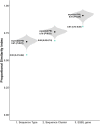Comparative genomics of ESBL-producing Escherichia coli (ESBL-Ec) reveals a similar distribution of the 10 most prevalent ESBL-Ec clones and ESBL genes among human community faecal and extra-intestinal infection isolates in the Netherlands (2014-17)
- PMID: 33428729
- PMCID: PMC7953314
- DOI: 10.1093/jac/dkaa534
Comparative genomics of ESBL-producing Escherichia coli (ESBL-Ec) reveals a similar distribution of the 10 most prevalent ESBL-Ec clones and ESBL genes among human community faecal and extra-intestinal infection isolates in the Netherlands (2014-17)
Abstract
Introduction: The human gut microbiota is an important reservoir of ESBL-producing Escherichia coli (ESBL-Ec). Community surveillance studies of ESBL-Ec to monitor circulating clones and ESBL genes are logistically challenging and costly.
Objectives: To evaluate if isolates obtained in routine clinical practice can be used as an alternative to monitor the distribution of clones and ESBL genes circulating in the community.
Methods: WGS was performed on 451 Dutch ESBL-Ec isolates (2014-17), including 162 community faeces and 289 urine and blood isolates. We compared proportions of 10 most frequently identified STs, PopPUNK-based sequence clusters (SCs) and ESBL gene subtypes and the degree of similarity using Czekanowski's proportional similarity index (PSI).
Results: Nine out of 10 most prevalent STs and SCs and 8/10 most prevalent ESBL genes in clinical ESBL-Ec were also the most common types in community faeces. The proportions of ST131 (39% versus 23%) and SC131 (40% versus 25%) were higher in clinical isolates than in community faeces (P < 0.01). Within ST131, H30Rx (C2) subclade was more prevalent among clinical isolates (55% versus 26%, P < 0.01). The proportion of ESBL gene blaCTX-M-1 was lower in clinical isolates (5% versus 18%, P < 0.01). Czekanowski's PSI confirmed that the differences in ESBL-Ec from community faeces and clinical isolates were limited.
Conclusions: Distributions of the 10 most prevalent clones and ESBL genes from ESBL-Ec community gut colonization and extra-intestinal infection overlapped in majority, indicating that isolates from routine clinical practice could be used to monitor ESBL-Ec clones and ESBL genes in the community.
© The Author(s) 2021. Published by Oxford University Press on behalf of the British Society for Antimicrobial Chemotherapy.
Figures




Similar articles
-
Community carriage of ESBL-producing Escherichia coli and Klebsiella pneumoniae: a cross-sectional study of risk factors and comparative genomics of carriage and clinical isolates.mSphere. 2023 Aug 24;8(4):e0002523. doi: 10.1128/msphere.00025-23. Epub 2023 Jun 12. mSphere. 2023. PMID: 37306968 Free PMC article.
-
Population snapshot of the extended-spectrum β-lactamase-producing Escherichia coli invasive strains isolated from a Hungarian hospital.Ann Clin Microbiol Antimicrob. 2022 Feb 10;21(1):3. doi: 10.1186/s12941-022-00493-8. Ann Clin Microbiol Antimicrob. 2022. PMID: 35144632 Free PMC article.
-
Extended-spectrum beta-lactamase (ESBL)-producing and non-ESBL-producing Escherichia coli isolates causing bacteremia in the Netherlands (2014 - 2016) differ in clonal distribution, antimicrobial resistance gene and virulence gene content.PLoS One. 2020 Jan 14;15(1):e0227604. doi: 10.1371/journal.pone.0227604. eCollection 2020. PLoS One. 2020. PMID: 31935253 Free PMC article.
-
Emergence of ESBL-producing Escherichia coli ST131-C1-M27 clade colonizing patients in Europe.J Antimicrob Chemother. 2018 Nov 1;73(11):2973-2980. doi: 10.1093/jac/dky296. J Antimicrob Chemother. 2018. PMID: 30124851
-
Measures used to assess the burden of ESBL-producing Escherichia coli infections in humans: a scoping review.JAC Antimicrob Resist. 2021 Feb 14;3(1):dlaa104. doi: 10.1093/jacamr/dlaa104. eCollection 2021 Mar. JAC Antimicrob Resist. 2021. PMID: 34223063 Free PMC article.
Cited by
-
Gut Colonization by ESBL-Producing Escherichia coli in Dogs Is Associated with a Distinct Microbiome and Resistome Composition.Microbiol Spectr. 2023 Aug 17;11(4):e0006323. doi: 10.1128/spectrum.00063-23. Epub 2023 Jul 5. Microbiol Spectr. 2023. PMID: 37404183 Free PMC article.
-
Extended-Spectrum β-Lactamase and carbapenemase-producing Escherichia coli O157:H7 among diarrheic patients in Shashemene, Ethiopia.PLoS One. 2024 Aug 1;19(8):e0306691. doi: 10.1371/journal.pone.0306691. eCollection 2024. PLoS One. 2024. PMID: 39088560 Free PMC article.
-
First Report of bla CTX-M-167, bla SHV-1, and bla TEM-1B Carrying Klebsiella pneumonia Showing High-Level Resistance to Carbapenems.Front Microbiol. 2022 Jul 7;13:916304. doi: 10.3389/fmicb.2022.916304. eCollection 2022. Front Microbiol. 2022. PMID: 35875519 Free PMC article.
-
Extra-intestinal pathogenic lineages of extended-spectrum β-lactamase (ESBL)-producing Escherichia coli are associated with prolonged ESBL gene carriage.Access Microbiol. 2024 Feb 12;6(2):000541.v4. doi: 10.1099/acmi.0.000541.v4. eCollection 2024. Access Microbiol. 2024. PMID: 38482367 Free PMC article.
-
Genetic profiling of extended-spectrum β-Lactamase and carbapenemase-producing Escherichia coli O157:H7 from clinical samples among diarrheal patients in Shashemene, Ethiopia.BMC Infect Dis. 2025 Jan 20;25(1):90. doi: 10.1186/s12879-025-10513-5. BMC Infect Dis. 2025. PMID: 39833755 Free PMC article.
References
-
- PHE 2019. Annual epidemiological commentary: bacteraemia, MSSA bacteraemia and C. difficile infections, up to and including financial year April 2018 to March 2019. https://assets.publishing.service.gov.uk/government/uploads/system/uploa....
-
- ECDC 2019. Surveillance of antimicrobial resistance in Europe 2018. https://www.ecdc.europa.eu/sites/default/files/documents/surveillance-an....
-
- Coque TM, Baquero F, Canton R.. Increasing prevalence of ESBL-producing Enterobacteriaceae in Europe. Euro Surveill 2008; 13: pii=19044. - PubMed
-
- Rodríguez-Baño J, López-Cerero L, Navarro MD. et al. Faecal carriage of extended-spectrum β-lactamase-producing Escherichia coli: prevalence, risk factors and molecular epidemiology. J Antimicrob Chemother 2008; 62: 1142–9. - PubMed
Publication types
MeSH terms
Substances
LinkOut - more resources
Full Text Sources
Other Literature Sources
Medical
Miscellaneous

